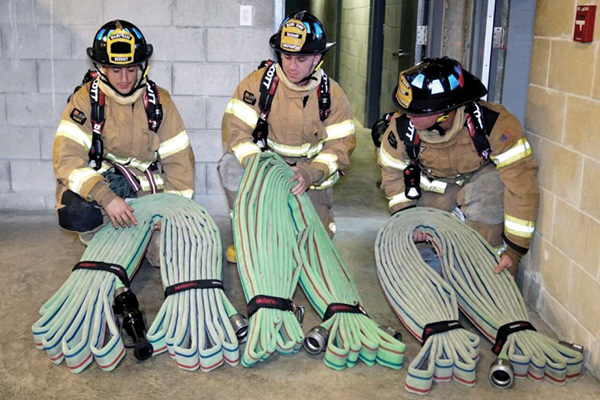
By Bill Gustin
The first objective of firefighting strategy is the protection of civilian lives. This can be achieved in one of two ways: (1) remove occupants from fire or (2) remove fire from occupants. Firefighters commonly remove occupants from fire in private residences and small multiple dwellings by operations such as interior search, ladder rescue, and vent-enter-isolate-search procedures. The second way to protect civilian lives, taking fire away from occupants, is achieved by controlling the fire. This is often the best way to protect lives in buildings that are too tall to be evacuated in a timely fashion or are occupied by residents who are physically impaired and cannot self-evacuate.
Occupancy is arguably the most important factor considered in a size-up of any fire building. Occupancy indicates what the building is used for, the risk to occupants, and the acceptable and appropriate level of risk to firefighters. Fire departments that have high-rise buildings housing a large number of elderly residents who depend on walkers and wheelchairs for mobility know that a protect/shelter-in-place strategy is not an option; it is a necessity.
Occupants and Communication
To control a fire in a high-rise building, fire officers must gain control of its systems, such as elevators; heating, ventilation, and air-conditioning (HVAC); standpipe systems; and, equally important, occupants. To effectively control occupants, fire officers must put themselves in their place. For example, something a fire officer would consider annoying and harmless such as smoke from a burning bag of microwave popcorn can be terrifying for elderly residents. For this and similar alarms, it is critical that fire officers use the building’s fire alarm public address system to advise and reassure occupants to stay in their units.
Similarly, when a building has a lobby front desk, fire officers must tell building management or security personnel what to tell occupants when they call the front desk for advice. Additionally, implementation of a protect-in-place strategy necessitates that incident commanders advise fire alarm dispatchers and 911 call takers, who will be inundated with calls from panicky residents, what to advise callers.
The best opportunity to advise residents of what to do is before a fire occurs in their building. Fire departments must reach out to tenant and condominium associations with public education programs to familiarize them with their building’s fire emergency plan. Convincing residents that they are safer if they remain in their residences instead of attempting to evacuate through smoke-filled hallways and stairwells is no easy task. Sadly, some will leave the refuge of their tenable units and succumb to smoke inhalation in hallways, stairwells, and elevator lobbies. To complicate matters, consider that residents may not be safer in their apartments or condo units. A closed door to the public hallway is no defense against a fire that is scaling the exterior of the building fueled by combustible cladding and autoexposing windows or going from balcony to balcony fueled by plastic patio furniture.
Although it is critical to rapidly get water on a fire to protect occupants of a high-rise building, it takes preparation. As firefighters, we are inclined and accustomed to taking immediate action to attack a fire, but attempting to attack a high-rise fire without a leader, before knowing essential preliminary information and without sufficient personnel, can delay getting water on a fire and allow the fire to intensify.
Personnel and Advancing the Hoseline
One of the biggest mistakes a fire officer can make is to attempt to advance a hoseline with insufficient personnel. Don’t underestimate how quickly personnel will tire and exhaust their self-contained breathing apparatus (SCBA) air supply. Fire officers may have to delay an advance to a fire until they have sufficient personnel to initiate, sustain, and complete an attack on the fire. For example, an engine crew of three, consisting of an officer and two firefighters, attempts to advance its charged 2½-inch hoseline up the stairs from the floor below the fire, around a corner in a smoke-filled hallway, and into the fire compartment. For the purpose of this article, the term “fire compartment” refers to a living or storage unit in a compartmented residential building such as an apartment, a condominium unit, a hotel room, or a linen or tenant storage room.
The result will be failure because they will become physically exhausted, run out of air in their SCBA, or a combination of both. At that point, they will have no choice but to abandon their hoseline, follow it back to the refuge of the attack stairway, and retire to the floor below the fire to rest and change their SCBA cylinder.
This begs the question: Did their failed hose advance make conditions better or worse? They probably made matters worse by chocking open doors between the attack stairwell and the smoke-filled fire floor, turning the stairwell into a chimney, and allowing additional oxygen to intensify the fire. Do not devise standpipe evolutions and determine personnel requirements based strictly on drilling in a training tower without hallways. This can result in underestimating the number of personnel needed to advance a hoseline down a long hallway and around corners, considering that stairwells may be as much as 400 feet apart.
There’s no question that high-rise firefighting operations are terribly personnel intensive whether the fire is in a large city or a suburban town. At a high-rise firefighting conference, I was asked to present a class on high-rise firefighting operations for suburban fire departments, following a presentation by another instructor on urban high-rise operations. I made it clear the tactics used to fight a high-rise building fire and personnel requirements are the same whether the fire is in midtown Manhattan or in small town Mid-America. The difference among urban, big-city, and suburban high-rise operations is that there are very few departments outside of big cities that can handle a high-rise building fire of any consequence by themselves. It is, therefore, critical that suburban fire departments collaborate to create mutual-aid agreements with neighboring departments and work together to develop regional high-rise operational procedures. It is very important that regional high-rise procedures don’t just look good on paper. A plan must be put to the test and fine-tuned by departments that train together in realistic high-rise fire scenarios. Additionally, interoperability is key in terms of command and control, radio terminology, tactics, fire hose coupling thread type, and diameter of hose used for standpipe operations. Excellent examples of regional high-rise plans are those developed by suburban Chicago area fire departments participating in the Mutual Aid Box Alarm System (MABAS) and fire and rescue departments of Northern Virginia.
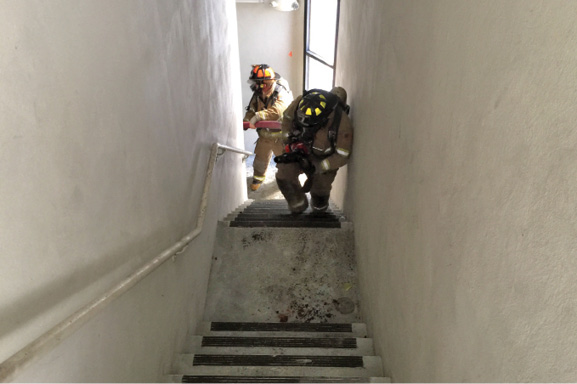
(1) When determining the length of hose and the number and position of personnel on a hoseline, consider that stairs between floors may have more than one intermediate landing because of the height of floors used for assembly areas and mechanical rooms at mezzanine levels. Here, firefighters are advancing a 2½-inch hoseline connected to a portable master stream device in an office building where the height between floors is not less than 25 feet. (Photos by Eric Goodman unless otherwise noted.)
Before Advancing the Hoseline
Before attempting a hoseline advance, fire officers must know the following information:
- The location of the fire and its distance from the attack stairwell, a determination necessary to estimate the length of hoseline needed to reach the fire area.
- The size of the fire compartment or area, a determination necessary to estimate the length of hoseline necessary for the nozzle’s stream to be within reach of every portion of the fire area.
- The configuration of the attack stairway (straight run, return, or scissors stairs) and the fire floor hallway. This intelligence is needed to determine the number and placement of personnel at corners and on stair landings and half-landings to keep hose moving where it changes directions. It is important to consider that stairs between floors may have more than one intermediate landing because of the height of floors for assembly areas such as restaurants, ballrooms, or conference rooms. Similarly, consider mechanical rooms on a mezzanine level between floors (photo 1).
- What are heat and smoke conditions in the public hallway on the fire floor? If the fire floor hallway is fairly clear of smoke, it is usually because the door to the fire compartment is closed. If personnel can maintain control of the door, they have the option of stretching their hoseline dry to the fire compartment, pulling up sufficient hose (at least 50 feet) so that every area will be within the reach of their stream, and then charging their line. The advantages and disadvantages of a dry hallway stretch will be examined in part 2 of this article. If the hallway is “dirty”—that is, full of smoke—it’s usually a result of the door to the fire compartment being open. A dirty hallway could also be the result of trash burning in the hallway or an intoxicated resident who lights his mattress on fire while smoking in bed and pulls it out into the public hallway and goes back to sleep. Personnel operating in a dirty hallway may be forced to their knees, below the layer of heat and smoke. Firefighters advancing hose while on their knees will tire quickly because they cannot use their leg muscles and have to depend entirely on their upper body strength.
- Are there sufficient personnel and spare SCBA cylinders to not only begin a hose advance but also to sustain it with sufficient personnel standing by to relieve personnel on the hoseline as they tire and expend their air supply?
- Are personnel already exhausted because they had to climb several stories of stairs?
- Has reverse stack effect contaminated stairwells with smoke, forcing personnel to climb stairs while “on air” and consuming their air supply before actually going to work?
- Have occupants using the attack stairwell to evacuate been directed to another stairway before firefighters chock open the door to the fire floor to advance their hoseline and fill the attack stairwell with smoke?
Who Is in Charge?
Few, if any, firefighting operations necessitate teaming up companies more than advancing a hoseline from a standpipe outlet. Consider that personnel will have to be strategically positioned along the hoseline to pull it from the floor below the fire and feed it into the attack stairwell up to a firefighter positioned at the half-landing between the fire floor and floor below if it is a return stairway. There, the firefighter operating at the half-landing will feed the hose to a firefighter positioned at the stairwell’s fire floor landing, who will feed it to the firefighters advancing the hoseline down the hallway to the fire compartment (photos 2, 3). Now consider that the hose must be maneuvered around corners in the hallway; this will require a firefighter at every change of direction (photo 4). This is the true essence of a multicompany operation, requiring the utmost teamwork, discipline, and leadership. Without adequate supervision, everyone on the hoseline who wants to get in the action will congregate at or near the nozzle. When undisciplined firefighters get in a dogfight for the nozzle, it may never reach the fire. A hoseline advance involving multiple companies requires strong, autocratic leadership, preferably by a senior officer who is not physically involved in the task. It is difficult for even the best company officer to effectively supervise a multicompany advance if he has his hands on the hoseline. When a chief officer arrives on the floor below a fire, he must determine the answer to two questions: (1) Is the first hoseline in operation? and (2) If it is not operating, why not?
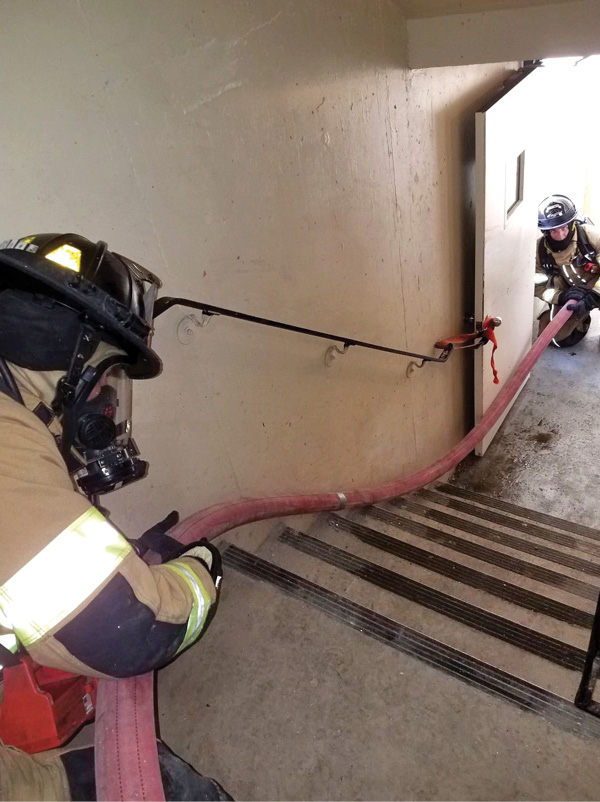
(2) Personnel have to be strategically positioned on a hoseline to keep it moving. A firefighter pulls hose from the floor below the fire into the attack stairwell and feeds it up to a firefighter positioned at the half-landing between the fire floor and floor below.
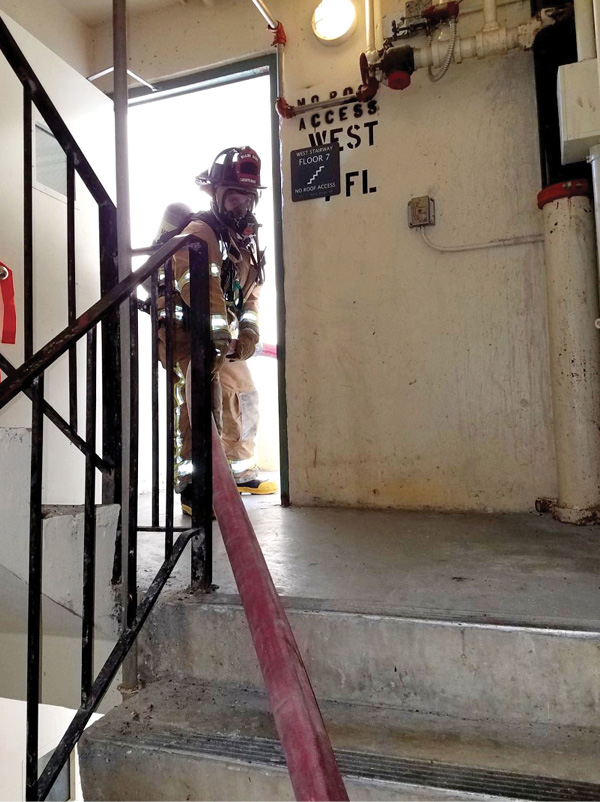
(3) A firefighter positioned at the stairwell’s fire floor landing feeds hose to the firefighters advancing the hoseline down the hallway.
When I was a young relief lieutenant, the engine company where I was detailed for the day responded on a high-rise building assignment to a fire in an extravagant waterfront luxury condominium building. The fire occupancy, on the seventh floor, was quite large, as much as 2,500 square feet. Prior to the arrival of the fire department, a well-intentioned security guard pulled a “house line” from a hose cabinet in the hallway and used his master key to open the door to the fire occupancy. At that time, it was common to find unlined 1½-inch hose for occupant use with a brass, long barrel, small-diameter, smooth bore nozzle with no shutoff. The hose was deployed by opening the outlet valve in the cabinet and pulling on the last fold of hose, which would release a clamp and allow the flow of water. After a brief taste of smoke, the security guard decided that he would leave the firefighting to the fire department and abandoned the flowing house line, blocking open the door to the fire residence. This resulted in smoke filling the public hallway to floor level and the fire department taking the blame for excessive water damage.
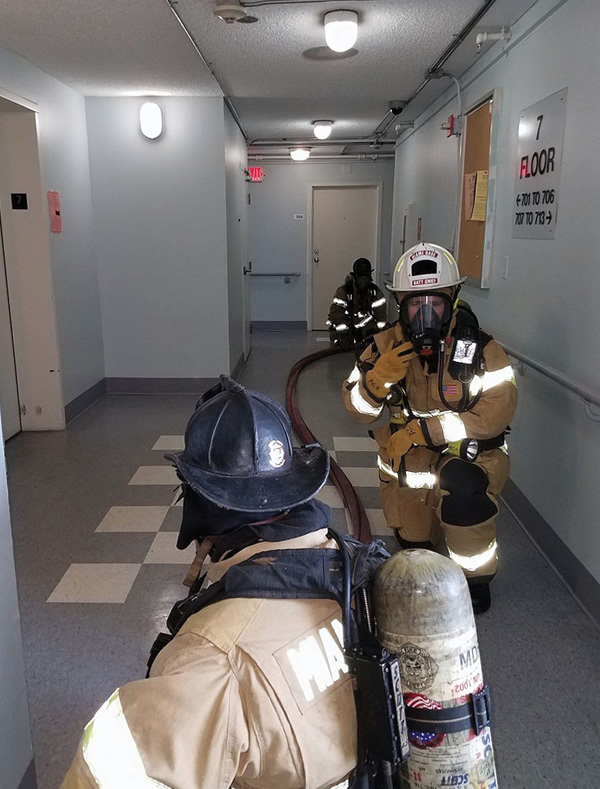
(4) Firefighters maneuver hose around corners in an elevator lobby. They are being directed by a battalion chief who, as fire floor division supervisor, is not physically involved in the task.
As companies assembled on the floor below the fire, chaos ensued as we debated how much hose to stretch and whether we should stretch it in the stairwell or in the hallway. Once the hoseline was charged, the advance was delayed as each company competed for the nozzle. This disorganized operation was starved for leadership, which would soon arrive when a veteran battalion chief took control. With a loud and commanding voice, the chief assigned a firefighter to the nozzle position, a backup firefighter behind the nozzle firefighter, and a firefighter to take a position at the door to the fire apartment. He then assigned personnel to pull hose on the floor below the fire to feed it to firefighters operating in the attack stairwell. Today, the chief’s harsh management style may hurt some sensitive feelings, but he decisively took charge of a group of undisciplined, inexperienced young firefighters; tuned them up; and organized them into an effective team.
Hose for Standpipe Operations
Few issues are as hotly debated as the diameter of hose used for standpipe operations, how it is configured into bundles, and the methods used to deploy it. Every fire department with responsibility for high-rise firefighting must select the diameter of its standpipe hose and devise deployment evolutions that are best for them based on an analysis of the buildings and fire suppression systems in their jurisdiction.
Scenario 1. For example, consider two fire departments. One department is in a rapidly growing metropolitan area with modern, fully sprinklered high-rise buildings, the oldest being built in the mid-1990s. Additionally, the department’s fire prevention bureau regularly inspects the high-rise buildings in their jurisdiction to ensure that their fire suppression systems are reliable by requiring that they are tested and maintained in full compliance with National Fire Protection Association (NFPA) 25, Standard for the Inspection, Testing and Maintenance of Water-Based Fire Protection Systems. Considering fire potential, this department may decide to use high-quality 1¾-inch hose for the primary attack line for standpipe operations but train to be proficient in deploying 2½-inch hose in the rare event of a fire that exceeds the suppression capabilities of its 1¾-inch hose.
Scenario 2. Now consider a second department that has old, nonsprinklered buildings in its jurisdiction and recklessly neglects to inspect them to ensure that their suppression systems are in compliance with NFPA 25. Clearly, this second department needs standpipe hose that can operate as effectively as possible with low-system pressures, making 2½-inch hose a good choice.
Occupancy is also an important factor when making decisions concerning standpipe hose. Residential buildings are largely compartmented into living units and public areas. Compartmentation tends to limit the potential volume of fire to within the suppression capabilities of a hoseline flowing 185 to 200 gallons per minute (gpm).
In contrast, office buildings tend to have large, undivided floor areas and partitions separating offices typically extend to the ceiling, leaving the space above it wide open, commonly functioning as an HVAC air-return plenum. Large areas are conducive to a large volume of fire that demands the flow of 2½-inch hoselines and portable master stream devices. When choosing the diameter of hose for standpipe operations, staffing is an important criterion, but it cannot be the deciding factor. Fire is an unthinking, unsympathetic chemical reaction that, frankly, doesn’t care whether a fire department is understaffed. If a department that deploys 1¾-inch hose because of limited staffing finds itself at a high-rise fire that requires the flow of a larger-diameter hoseline, it will fail to control the fire and take a beating until it consumes sufficient fuel to reduce its heat energy to within the department’s suppression capability.
When choosing hose for standpipe operations, innovations in the fire hose industry is a huge consideration. For example, in the 1990s, the friction loss in standard 1¾-inch hose flowing 185 gpm was 40 to 60 pounds per square inch (psi) per 100 feet; today, that friction loss in the same labeled 1¾-inch hose can vary between 25 and 50 psi. The reason for this is that the inside diameter (ID) of today’s labeled 1¾-inch hose can be 1¾ inch to 1.88 inches with no water pressure increasing its inside diameter. It used to be that a fire department had only two choices of standpipe hose—1¾- and 2½-inch diameter. Now, there are alternatives. Today, two-inch hose is available with 1½- and 2½-inch couplings, and it is in use by several fire departments.
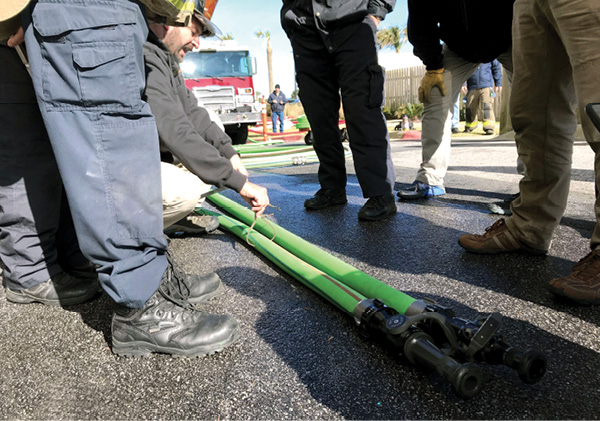
(5) A side-by-side comparison of two-inch hose with 2½-inch couplings and a recent development—hose with an inside diameter of exactly 2¼ inches. (Photo by Al Zuccarelli.)
All hose will expand and elongate under pressure. Generally, hose will expand internally approximately three percent at fireground operational pressures. The ID of hose when it is at rest—that is, not under pressure—dictates its overall ID when it is pressurized. Elongation depends on the diameter of the hose and ranges between eight and 13 percent. The increase in the cross-sectional area of hose is not always desirable because it increases the amount and, consequently, the weight of water in the hose. As a result, the fire service has begun a movement to persuade the fire hose industry to produce products with a true ID—such as true ID 2½-inch hose and, most recently, 2¼-inch-diameter hose (photo 5).
I make no recommendations on hose for standpipe operations in this article, but I strongly recommend that fire departments choose their standpipe hose wisely by doing their homework and knowing their buildings, flow testing a variety of hose and nozzle combinations, and looking at new products developed by the fire hose industry (see “Flow Testing”). It may be that at the end of the day a department will choose to change to or continue to use 2½-inch hose, but that conclusion will be based on its research and test results and its community’s needs.
Miami-Dade Upgrades Its Standpipe Hose
The heat release rates of petrochemical-based synthetic (plastic) contents in high-rise buildings has increased significantly over the years while the flow capabilities of 1¾-inch hose used by the Miami-Dade (FL) Fire/Rescue Department remained the same. Following two high-rise fires that exceeded the flow capabilities of 1¾-inch hose, the department realized it had to increase its flow for standpipe operations. But, the question arose: “Is a change to 2½-inch hose the only option?” The department considered innovations in the fire hose industry to see if it was possible to find hose that approximated the flow of 2½-inch hose and had handling characteristics similar to those of 1¾-inch hose.
After flow testing and performing evolutions with various lengths and diameters of hose, the department decided to issue to each fire company three 75-foot sections of two-inch hose with 2½-inch couplings. When equipped with a 11/8-inch smooth bore nozzle tip, the hose is capable of flowing 250 gpm at a nozzle pressure of 45 psi. (At that flow, the friction loss in one 75-foot section is approximately 20 psi.)
The department chose 75-foot sections because companies typically operate in high-rise buildings with an officer and two firefighters with driver-engineers performing functions such as supplying fire department connections and ensuring that the building’s fire pumps are operating and suppression system valves are open and marshaling SCBA air cylinders. With three 75-foot sections, each member can carry one section configured in an accordion bundle fold that can be bent in half to form a horseshoe that can be carried over the shoulder or SCBA cylinder (photo 6).

(6) Three bundles of 75-foot sections of two-inch hose configured into horseshoes. (Photo by Ricardo Stephens.)
Although two-inch hose is available with 1½-inch couplings, the department chose 2½-inch couplings because they could use the same 11/8-inch nozzle that is being used on its 2½-inch hose. Interoperability was also a factor: Not all neighboring departments have the same 1½-inch coupling thread, but they all have compatible threads on their 2½-inch couplings. (Choosing a 11/8-inch nozzle violates the old cardinal rule about the diameter of the nozzle not exceeding half the diameter of the hose, but advances in modern fire hose have changed this and other rules.)
Flow Testing

(1) How a pitot tube is held in a nozzle’s stream will affect the result of a flow test. (Photo by Eric Goodman.)
Identifying and Correcting Problems
An analysis of high-rise fires in Miami-Dade County over several years has identified the following recurring operational problems that led to changes in the department’s standpipe hose evolutions:
- The region’s hot tropical weather often causes a reverse stack effect, resulting in smoke filling stairwells several floors below the fire floor. Limited visibility in stairwells because of smoke often led to kinks in hoselines when they were stretched dry in stairwells. Additionally, throngs of fleeing occupants, often carrying possessions, pets, and small children, often interfered with stretching hose in the attack stairwell and were at risk of tripping over uncharged hose.
- There was confusion over whether to charge the hoseline in the attack stairwell on the floor below the fire floor or stretch dry to the fire compartment. This was caused in large part by an individual officer’s perception of smoke conditions and visibility in the stairwell and the public hallway.
- There was confusion and delay in charging a hoseline and adjusting its pressure when it was connected to a standpipe outlet on the floor below the fire and stretched dry to the fire compartment. This often resulted in insufficient or excessive pressures.
- There was loss of control of the door to the fire compartment when residents, security, or building maintenance opened it unexpectedly or police officers kicked it in, resulting in rapidly deteriorating conditions in the public hallway.
When devising and managing standpipe hose evolutions, a department must consider the realities of training and skill levels of individual fire companies. In a perfect world, companies would train together until they were highly proficient in stretching and advancing hoselines from standpipes. Unfortunately, that is seldom the case now. With competing demands for training and pressure for companies to remain in service to respond to medical calls, the time allotted for realistic, intense, high-quality multicompany standpipe drills is extremely limited. Cohesion of fire company personnel is also a significant consideration. Standpipe evolutions that look good in an operation manual or have been rehearsed several times for a training video may fall apart when firefighters who have never worked or trained together attempt them.
Part 2 will examine why Miami-Dade Fire/Rescue simplified its standpipe hose evolutions and made them more consistent by reducing options for deployment. It will also examine why the department eliminated the use of a wye for standpipe operations and some unconventional tactics such as deploying a Bresnan rotating distributor nozzle for wind-driven fires and improvising a “portable standpipe” should a standpipe system fail.
BILL GUSTIN is a 45-year veteran of the fire service and a captain with the Miami-Dade (FL) Fire/Rescue Department. He began his fire service career in the Chicago area and is a lead instructor in his department’s Officer Development Program. He teaches tactics and company officer training programs throughout North America. He is an advisory board member of Fire Engineering and FDIC International.
RELATED
Webcasts with Bill Gustin on Standpipe Operations
FDIC International 2019: Interview with Bill Gustin
Standpipe Operations: Preparation
Standpipe Operations: Stretching and Advancing Hose
Operating More Than One Hoseline from a Standpipe

